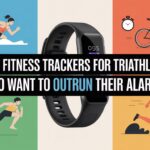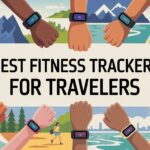Fitness trackers have basically become our workout sidekicks. They’re always there, counting every step, tracking every sweaty mile, and sometimes giving us a judgmental buzz when we take the elevator instead of the stairs.
These little wrist-huggers know more about us than we’d probably admit—like how often we bail on leg day or how rarely we get enough sleep. For runners, cyclists, or anyone obsessed with numbers, they make training smarter and sharing progress just a bit more fun (and maybe a little less humblebrag-y).
Pairing a fitness tracker with Strava? That’s like adding a turbo boost to your workouts. Strava turns exercise into a competition, letting us compare our best (or, let’s be real, worst) efforts with friends and random strangers.
Not every tracker works smoothly with Strava, and some miss key stuff like heart rate or GPS accuracy. So picking the right one actually matters. Comfort, battery life, and how much buzzing we can handle on our wrists—those are real concerns too.
We kept all that in mind as we hunted for the best fitness trackers that make syncing with Strava easy and tracking workouts way more enjoyable.
Best Fitness Trackers for Strava Users
We’ve all had that moment—thinking we ran faster than our friend, but Strava says otherwise. To help us track every step, bead of sweat, and small victory, here are the best fitness trackers that actually work well with Strava.
Let’s make sure our stats are brag-worthy and, this time, accurate.
Fitbit Inspire 3
If you just want a no-nonsense tracker that mostly plays nice with Strava and doesn’t need a daily charge, the Fitbit Inspire 3 is a solid option.
Pros
- Reliable for basic fitness and health stats
- Battery life that actually lasts
- Sleep and stress tracking for a bigger picture
Cons
- No built-in GPS—it borrows your phone’s
- Premium features hide behind a paywall after the trial
- Syncing with Strava sometimes tests your patience
When we first put on the Inspire 3, we barely noticed it. It’s that light, honestly. We usually forgot about it until it buzzed to remind us to move.
The battery life impressed us—it sometimes hit almost ten days before we had to hunt for the charger. Syncing workouts to Strava worked fine, as long as we brought our phones along. Since Inspire 3 doesn’t have its own GPS, our phone has to come with us if we want accurate maps.
Syncing took an extra step, but we got there—maybe with a tiny bit of grumbling. Sleep tracking turned out to be a nice bonus. We finally saw proof of our terrible bedtime habits.
Some health insights, like the Daily Readiness Score, lock us out unless we pay for Fitbit Premium after the free trial. If you just want the basics, that’s not a huge deal, but it’s kind of annoying.
So, Fitbit Inspire 3 is great if you want reliable, entry-level tracking and some Strava integration. Just don’t expect GPS magic unless your phone is glued to your side.
Fitbit Inspire 3 Tracker
If you just want a tracker that fits under your shirt sleeve and works with Strava, the Fitbit Inspire 3 is a smart pick.
Pros
- Super lightweight—you’ll forget it’s on
- Sleep tracking is detailed enough to explain our crankiness
- Syncs with Strava without much effort
Cons
- No built-in GPS, so your phone is still coming along
- The screen can be hard to see in bright sunlight
- Touch navigation isn’t always smooth
Let’s be real, not everyone wants a massive device on their wrist. The Fitbit Inspire 3 nails that minimal vibe. It’s so comfortable we wore it for days and barely noticed.
But we definitely noticed all the data it grabs—from our attempts at running to those half-asleep fridge trips. Syncing with Strava is easy. It logs our walks, jogs, and even those random dance battles with no drama.
You do need your phone for GPS mapping, so phone-free runs aren’t happening. But after workouts, all the activity data lands right in Strava, ready for your friends to admire (or judge).
Everyday health tracking is where Inspire 3 shines. The sleep analysis is thorough, and step tracking feels more accurate than our phones. The notifications and battery life keep us connected and lazy about charging.
Sunlight can make the display hard to read, though. If you want a tracker that helps your Strava habit without costing a fortune or bulking up your wrist, this Fitbit gets our vote.
Fitbit Inspire 2
If you want a reliable tracker that works with Strava and doesn’t try to be your best friend, the Fitbit Inspire 2 is a pretty solid pick.
Pros
- Battery lasts over a week, so charging is rare
- Comfortable—you’ll barely notice it until it buzzes
- Syncs with Strava without any headaches
Cons
- No built-in GPS—it uses your phone’s
- The screen is small, so you might squint sometimes
- Full features require Premium after the free year
Wearing the Inspire 2 feels like strapping on a tiny, polite drill sergeant. It nudges us to move and cheers for our “vigorous” coffee runs.
It tracks sleep better than our pets ever could. Syncing with Strava is smooth, so you can show off your power walks or runs with no hassle.
It’s light, slim, and doesn’t leave a mark on your wrist. Daily step counts and heart rate reminders keep us honest, but not in an annoying way.
We love only needing to charge it once every ten days. Our chargers deserve a break.
If you want all the extra insights, meal plans, and sleep reports, Fitbit will ask you to pay for Premium after a year. Since it doesn’t have built-in GPS, your phone has to come along for runs. That’s not ideal if you dream of phone-free workouts. Still, the Inspire 2 keeps us moving without turning us into a walking tech ad.
Amazfit Active 2 Smart Watch
If you want your runs mapped, your sleep tracked, and your wrist looking a little less sad, the Amazfit Active 2 Smart Watch might be your new favorite.
Pros
- Stylish design that doesn’t scream “I run marathons”
- Built-in GPS and free offline maps with turn-by-turn directions
- Battery that lasts longer than our motivation
Cons
- No touchscreen magic for Strava segments (manual sync only)
- Voice control sometimes mistakes heavy breathing for commands
- The Zepp app’s layout needs some work
Wearing this sleek watch made us feel a little fancier and a lot more ready to track workouts with Strava.
The bright display is easy to read, whether you’re running in full sun or stretching in the shade. Heart rate and sleep tracking felt pretty accurate—definitely more reliable than our friends’ guesses.
The 10-day battery is a lifesaver. We finally stopped searching for a charger every night.
Offline maps with turn-by-turn directions kept us from getting lost, which is great since our sense of direction is questionable at best. GPS locked on quickly, so we spent more time running and less time waiting around.
Syncing with Strava isn’t automatic, but it’s not hard either. Everything ends up in the Zepp app, though you might need to poke around to find certain features.
The voice assistant works unless you’re gasping for air after a sprint—then it just gets confused.
If you want something stylish and functional to pair with Strava, and you care about battery life as much as step tracking, the Amazfit Active 2 is an easy pick. It keeps us motivated and on track, even if it can’t run the miles for us.
Garmin Forerunner 55
Looking for a fitness watch that just works with Strava and doesn’t make your wrist look like a sci-fi prop? The Forerunner 55 is an easy choice.
Pros
- Simple training suggestions nudge us along, even on those “what day is it?” mornings.
- It’s so lightweight we forget it’s there—until it vibrates to cheer us on.
- Syncs with Strava like it’s desperate to join our running club.
Cons
- The display isn’t exactly eye candy.
- The small watch face might have us squinting like we’re reading ant handwriting.
- No touchscreen, so we’re poking tiny buttons like it’s the early 2000s.
We threw on the Forerunner 55 and hit the trail. It honestly feels like Garmin peeked at our running habits.
Daily workout suggestions pop up quietly and usually match our mood—whether we want to sprint or just shuffle around the block.
Strava connection? Couldn’t be easier.
After a sweaty run, the watch shoots our activity over to Strava through the Garmin app without any drama.
No cables, no emails, just instant sharing (for better or worse).
Buttons handle all the navigation, so even when our fingers are wet or clumsy, it still works.
Battery life is solid—we made it through a two-week vacation without running out, unless we totally forgot to charge.
Just don’t expect a fancy, colorful display—this screen means business.
Fitbit Charge 6
Want a tracker that’s glued to Strava and loaded with Google perks? If you can live without an altimeter, the Charge 6 keeps us sharp, comfy, and almost guilt-free about the price.
Pros
- Syncs with Strava smoothly, so our workouts look more impressive (even if we’re mostly walking).
- Real-time heart rate pops up on gym machines, making us look like pros.
- Google features help us get lost less and grab snacks without digging for our phones.
Cons
- No altimeter, so epic stair runs don’t count for much.
- The band can get stiff, especially after a sweaty workout.
- Battery drains fast if we turn on every feature at once.
We dove into the Charge 6 for those Google tricks, hoping not to get lost on our favorite runs.
The built-in GPS is clutch for pace tracking, and Google Maps on the wrist means fewer “creative” detours.
It syncs with Strava instantly—our stats go public before we’ve even caught our breath.
Contactless pay is almost too convenient.
We can grab water at the corner store with a flick of the wrist.
The heart rate shows up on select gym machines, so we look fancy even if we’re just pretending to jog.
We do get annoyed by the stiff band on long days.
It also bugs us that steep climbs aren’t tracked (thanks to the missing altimeter).
Still, the design is light enough to forget about most of the day.
If you want easy Strava tracking and a bunch of Google extras, the Charge 6 is a strong pick.
Fitbit Versa 4 Smartwatch
Looking for a tracker that keeps up with Strava goals and nudges you off the couch? Versa 4 might just be your new wrist buddy.
Pros
- Tracks workouts with Strava and shows stats right on the wrist.
- Battery lasts about a week—honestly impressive.
- Touchscreen is easy, and there are plenty of exercise modes.
Cons
- Some features hide behind a subscription paywall.
- The band starts stiff and needs breaking in.
- No music storage, so the phone still comes to the gym.
Out of the box, the Versa 4 feels like a tiny, polite coach.
We track runs, bike rides, and more without endless tapping.
Syncing with Strava is easy—no more hiding our fastest 5k from friends.
Battery life gives us real freedom.
We’ve gone nearly a week without charging, which means less cable hunting and more trail time.
The touchscreen is simple; even post-run shaky hands can swipe through stats.
We don’t love that some extras cost money after the trial.
No music storage means we still need our phones for tunes.
But if Strava tracking and clear fitness feedback are what you want, Versa 4 keeps it smart and simple.
LIVIKEY Fitness Tracker Watch
Need a budget-friendly tracker for Strava that covers the basics? LIVIKEY keeps it simple and easy on the wallet.
Pros
- Tracks steps, heart rate, and sleep with better accuracy than we expected.
- Holds a charge for almost a week, so we’re not always searching for a cord.
- Comfortable and light—easy to forget we’re even wearing it.
Cons
- The display is tiny, tough to read mid-jog if your eyes are as tired as your legs.
- No built-in GPS, so don’t ditch the phone if you want accurate routes.
- The QR code in the manual led us to a sketchy site—scan with caution.
We threw on the LIVIKEY and quickly realized it covers all the basics we care about.
It counts steps, tracks our heart rate, and calls us out on our sleep habits.
Its lightweight build means we could wear it all day, unless we wanted a break.
During runs, checking our step count was easy—no need to fumble with a phone.
Tracking calories and activity goals left us more motivated than we expected.
We even survived a rainstorm with it.
The waterproof rating held up, and we didn’t have to buy a replacement after getting soaked.
The display, though, is tough to read in the middle of a workout, especially if sweat or age is working against us.
The missing GPS means Strava routes only sync if we keep our phone close.
And seriously, don’t scan that QR code unless you like suspicious websites.
For the price, though, LIVIKEY is a solid pick for tracking the basics.
Amazfit Band 7
Want serious Strava stats without charging every night? The Amazfit Band 7 makes life easier—and a little lazier.
Pros
- Wildly long battery life (we almost forgot where the charger even was).
- Tracks more activities than we manage in a month.
- Alexa answers questions, so we don’t have to dig out our phones.
Cons
- No onboard GPS—our phone has to come along.
- The slim band isn’t for chunky watch fans.
- AMOLED screen struggles in bright sunlight.
Slipping this tracker on is easy—unless you’re like us and can’t handle a watch buckle before coffee.
The display is bright and clear, so we check our stats more often just because they look good.
Tracking all the things? It’s got us: heart rate, sleep, stress, blood oxygen, and more.
The battery is easily our favorite part.
We ignore it for almost three weeks straight, and it still tracks our runs, rides, and questionable yoga attempts.
Having Alexa on hand means we ask about the weather or set reminders without grabbing the phone.
There is a catch: it relies on your phone for GPS, so it’s not great for phone-free outings.
For the price, though, this slim tracker packs a punch and won’t overcomplicate your life.
It’s perfect for anyone who wants strap-and-go convenience.
Garmin vívosmart 5
Want a tracker that’s smarter than us but less moody than our phones? vívosmart 5 lands right in that sweet spot.
Pros
- Simple enough for even our tech-averse relatives.
- Tracks heart rate, sleep, and more—no PhD required.
- Battery lasts longer than a day (which is honestly rare).
Cons
- The screen is tiny—great for ants, just okay for humans.
- Needs your phone’s GPS for Strava.
- The design is plain, so don’t expect style points.
We strapped on the vívosmart 5 and instantly felt a bit more organized.
It’s lightweight, fits skinny wrists, and doesn’t scream for attention.
Basic stats like steps, heart rate, and stress all show up easily.
Strava connection is painless with the Garmin Connect app.
Notifications buzz on our wrist, so we see messages while pretending to pay attention in meetings (or mid-jog, which is more fun).
Sleep tracking works better than our memory after a long week.
The battery never left us panicking mid-workout.
If you like swimming, you can dive in without worrying about ruining it.
It’s not the flashiest tracker, but it gets the job done without fuss.
We just wish the display was easier to see, and the lack of built-in GPS means you’ll need your phone for Strava rides.
Great for anyone who wants practical fitness info without turning their wrist into a mini smartphone.
Buying Guide
When we’re hunting for the best tracker for Strava, we just want something that makes life easier. Nobody enjoys tech that feels like it belongs in the Stone Age, so check if your tracker connects to Strava without a fuss.
Battery life matters, too. It’s the worst when your fitness tracker dies halfway through a run. Let’s grab one that actually lasts longer than our morning search for clean socks.
Comfort? Absolutely essential. No one wants a tracker that digs in or irritates their skin. We’d rather focus on burning calories than battling chafing.
Let’s be honest—features only count if they work well. We need solid accuracy for steps, heart rate, and GPS. If your watch can take a splash or two (or survive the classic “oops, I spilled water again”), that’s a bonus.
Here’s a quick cheat sheet for picking one:
| Feature | What to Think About |
|---|---|
| Strava Sync | Easy, fast connection |
| Battery Life | At least a couple of days |
| Comfort | Lightweight, soft band |
| GPS Accuracy | Reliable mapping and distance |
| Water Resistance | Can handle sweat and some splashes |
| Heart Rate | Decent accuracy, not wild guesses |
| Display | Easy to read in sunlight |
We’re probably not all pro athletes, but the right tracker can make us feel like we could jog a marathon. Or at least until we spot a comfy bench nearby.
- Best Bluetooth Headphones for Airplane Travel: Drown Out Crying Babies in Style - December 8, 2025
- How to use Bluetooth headphones with an intercom system and Finally Escape Tangled Wires - December 7, 2025
- Best Fitness Trackers for Silent Alarms: Wake Up Without the Drama - December 7, 2025















